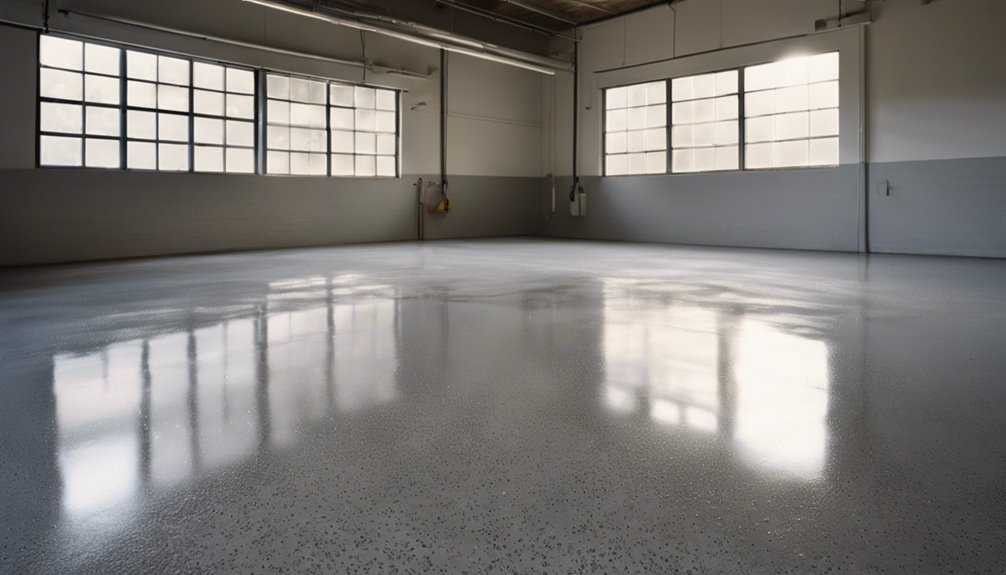To seal your concrete floor, start by evaluating its condition. Identify any cracks and clean them; fill cracks wider than 1/8 inch. Choose the right sealant—epoxy for durability or acrylic for breathability. Prepare the surface thoroughly, then apply the sealant using a roller for large areas or a sprayer for detailed sections, following manufacturer guidelines for the best results. Allow proper curing by maintaining temperatures between 50°F and 90°F with 40%-60% humidity. Finally, keep up with maintenance to prolong the seal's effectiveness. For further insights on specific techniques and products, there's more useful information ahead.
Assessing Your Concrete Floor
Before you begin sealing your concrete floor, how do you determine its condition? Start with a crack assessment, inspecting for visible fissures or surface damage. Use a concrete grinder or chisel to clean out any debris in the cracks, allowing for a clear evaluation. Measure the crack width; anything wider than 1/8 inch may require repair before sealing.
Next, conduct a moisture inspection. Place a plastic sheet on the surface and seal the edges. After 24 hours, check for condensation underneath. If moisture accumulates, it indicates potential issues with water intrusion or high humidity, which must be addressed. Identifying these factors guarantees you're sealing a sound foundation, ultimately prolonging the life of your concrete flooring and maximizing your investment.
Choosing the Right Sealant
When it comes to sealing your concrete floor, selecting the appropriate sealant is essential for ideal protection and longevity. You'll need to evaluate the different types of sealants available, their application methods, and how durable they are in your specific environment. Making an informed choice here will enhance your floor's performance and lifespan.
Types of Sealants
Choosing the right sealant for your concrete floor is essential, as it directly impacts durability and maintenance. Two main types of sealants to evaluate are epoxy sealants and acrylic sealants. Epoxy sealants offer superior durability and chemical resistance, making them ideal for high-traffic areas or spaces exposed to harsh conditions. They bond tightly to the concrete surface, providing a glossy finish that enhances aesthetics. On the other hand, acrylic sealants are easier to apply and provide a breathable finish, which allows moisture to escape from the concrete. They're suitable for indoor applications and light-duty outdoor use. Ultimately, your choice should reflect the specific conditions and requirements of your space, ensuring long-lasting protection and performance.
Application Methods
While selecting a sealant is essential, understanding the application methods is equally important for achieving ideal results. You've got two primary options: roller application and spray application.
With roller application, you can guarantee an even coat, making it ideal for large, flat surfaces. Just load the roller with sealant and apply in straight lines, overlapping slightly to avoid missed spots.
On the other hand, spray application offers a quicker method, especially for intricate areas or textured surfaces. It allows for a uniform finish and reduces the risk of streaks.
Regardless of the method you choose, always follow the manufacturer's instructions for peak performance. Assess your project needs and select the application method that aligns with your desired outcome.
Durability Considerations
To guarantee long-lasting protection for your concrete floor, it's essential to take into account the durability of the sealant you select. Consider sealants that offer excellent long-term performance against wear, moisture, and chemicals. Epoxy and polyurethane sealants are often recommended for high-traffic areas due to their robust nature. Additionally, evaluate the environmental impact of the product; some sealants may contain volatile organic compounds (VOCs) that can affect indoor air quality. Opt for low-VOC or eco-friendly options that provide durability without compromising your health or the environment. Always check manufacturer specifications and warranties to confirm you're backing a product that can withstand the test of time and maintain its integrity under varying conditions.
Preparing the Surface
Before applying a sealant, verifying the concrete surface is properly prepared is vital for achieving ideal adhesion and durability. Start with thorough surface cleaning to remove dust, dirt, and oil. Use a pressure washer or a suitable cleaner to achieve a pristine surface. Next, inspect for any cracks or damage; surface repairs are essential to prevent future issues. Fill in cracks and patch any holes with a concrete repair compound.
| Task | Description |
|---|---|
| Surface Cleaning | Remove debris and stains |
| Surface Repairs | Fill cracks and patch holes |
| Final Inspection | Confirm the surface is even and clean |
Taking these steps will guarantee that your sealant adheres effectively, enhancing the longevity of your concrete floor.
Applying the Sealant
With the surface prepped and inspected, you're ready to apply the sealant. Begin by choosing your application technique—either a roller, sprayer, or brush. For large areas, a sprayer guarantees even coverage, while a roller provides control in tighter spaces. Before starting, pour a small amount of sealant into a paint tray if using a roller. Dip the roller, making sure it's adequately saturated, and apply in a consistent, overlapping pattern to prevent streaks. When using a sprayer, maintain a steady distance from the surface for uniform application. Here's a sealant tip: work in sections, allowing the first section to absorb before proceeding. This way, you'll achieve a flawless finish that enhances your concrete floor's durability and aesthetic appeal.
Curing and Drying Time
To achieve the best results, you need to understand the ideal curing conditions for your concrete floor. Factors such as temperature, humidity, and air circulation greatly influence drying time, so you'll want to monitor these closely. Proper attention to these elements guarantees your sealant adheres effectively and performs as intended.
Ideal Curing Conditions
While you're preparing to seal your concrete floor, understanding the ideal curing conditions is vital for achieving the best results. The best temperature for curing concrete is typically between 50°F and 90°F. This range allows for the chemical reactions necessary for proper curing without risking cracks or surface issues. Additionally, maintaining appropriate humidity levels between 40% and 60% is important; too much moisture can hinder the curing process, while too little can cause rapid evaporation, leading to defects. To guarantee these conditions, consider using curing blankets or damp curing methods if you're in a dry or hot environment. By monitoring these factors, you can enhance the durability and longevity of your sealed concrete floor.
Drying Time Factors
As you consider sealing your concrete floor, it's essential to understand that drying time hinges on several factors, including ambient temperature, humidity, and air circulation. Higher temperatures can accelerate the drying process, while cooler temperatures may prolong it. You'll need to monitor humidity levels, as excessive moisture in the air can slow down drying and lead to potential issues like trapping moisture under the sealant. Aim for a balance; ideal conditions usually involve temperatures between 50°F and 90°F (10°C to 32°C) and moderate humidity. Additionally, guarantee adequate air circulation to facilitate evaporation; stagnant air can hinder the drying process. By carefully managing these factors, you'll achieve a durable and well-sealed concrete floor.
Maintaining Sealed Concrete
Maintaining sealed concrete is essential for preserving its durability and aesthetic appeal over time. To keep your concrete in top shape, follow these key practices:
- Regular Cleaning: Use a pH-neutral cleaner and a soft-bristle broom to remove dirt and debris. This prevents staining and wear on the sealant.
- Periodic Inspections: Routinely check for cracks, peeling, or discoloration. Early detection can save you from costly repairs down the line.
- Reapplication of Sealant: Depending on traffic and exposure, reapply the sealant every 1-3 years to guarantee lasting protection.
Frequently Asked Questions
Can I Seal Concrete in Cold Weather?
When it comes to sealing concrete in chilly conditions, you'll want to tread carefully. Cold weather techniques are essential, as sealing temperature considerations can make or break your project. Ideally, you should wait for temperatures to rise above 50°F. If you must seal in cold weather, use products specifically designed for lower temperatures and guarantee the surface is dry. Just remember, patience is key for a flawless finish that'll last!
How Often Should I Reseal My Concrete Floor?
You should typically reseal your concrete floor every 1 to 3 years, depending on factors like traffic and exposure to elements. Regular concrete maintenance is vital to maintain its integrity and appearance. If you notice signs of wear, like fading or cracking, it's a good idea to reseal sooner. By keeping a close eye on the condition, you guarantee your concrete stays protected and looks great for years to come.
Is Sealing Concrete Floor Necessary for Outdoor Surfaces?
You might not realize it, but sealing your outdoor concrete surfaces can greatly enhance their durability. The outdoor environment exposes concrete to harsh elements that can lead to cracking and deterioration. By sealing it, you gain multiple benefits, like improved resistance to water, stains, and UV damage. This extra layer fortifies your surfaces, ensuring they withstand the test of time while maintaining their aesthetic appeal. So, yes, sealing's definitely necessary for outdoor durability!
What Happens if I Apply Sealant Too Thickly?
If you apply sealant too thickly, it can lead to several issues. Excessive sealant can impede surface adhesion, resulting in peeling or flaking as it dries. Poor adhesion compromises the protective qualities of the sealant, leaving your surface vulnerable to moisture and damage. Furthermore, a thick application may create an uneven finish, affecting the aesthetic appeal. To avoid these problems, it's essential to follow recommended sealant application guidelines for best performance and durability.
Can I Use a Mop on Sealed Concrete Floors?
Yes, you can use a mop on sealed concrete floors, but it's essential to choose the right mop types and cleaning techniques. Opt for a microfiber mop as it effectively captures dirt without scratching the surface. Avoid using excessive water; instead, dampen the mop lightly. Regularly clean the mop to prevent residue buildup. This approach guarantees your sealed floors remain pristine while allowing you the freedom to maintain a clean environment effortlessly.




